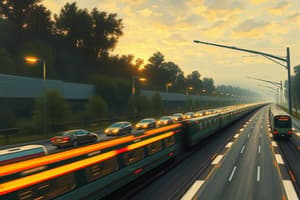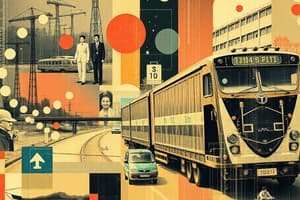Podcast
Questions and Answers
Which goal of the ITS program addresses environmental concerns?
Which goal of the ITS program addresses environmental concerns?
What financial challenge is cited for both public agencies and private-sector firms in transportation?
What financial challenge is cited for both public agencies and private-sector firms in transportation?
Which of the following is not mentioned as a method to achieve the goals of the ITS program?
Which of the following is not mentioned as a method to achieve the goals of the ITS program?
What significant change has been observed in institutional arrangements concerning transportation?
What significant change has been observed in institutional arrangements concerning transportation?
Signup and view all the answers
Which technological application has been indicated as beneficial for traffic control?
Which technological application has been indicated as beneficial for traffic control?
Signup and view all the answers
What is congestion pricing designed to achieve?
What is congestion pricing designed to achieve?
Signup and view all the answers
Which aspect is NOT a focus of agencies involved in transportation safety?
Which aspect is NOT a focus of agencies involved in transportation safety?
Signup and view all the answers
The Vienna Convention on Road Signs and Signals was established in which year?
The Vienna Convention on Road Signs and Signals was established in which year?
Signup and view all the answers
Which type of sign indicates potential hazards ahead on the road?
Which type of sign indicates potential hazards ahead on the road?
Signup and view all the answers
What is the primary goal of improved urban land-use planning in relation to traffic congestion?
What is the primary goal of improved urban land-use planning in relation to traffic congestion?
Signup and view all the answers
Which sign instructs road users on what they must or should do?
Which sign instructs road users on what they must or should do?
Signup and view all the answers
The shape of a typical warning sign is best described as:
The shape of a typical warning sign is best described as:
Signup and view all the answers
What challenge continues to be a priority for the transportation engineering profession?
What challenge continues to be a priority for the transportation engineering profession?
Signup and view all the answers
Which groups are generally seen as underserved in the transportation system?
Which groups are generally seen as underserved in the transportation system?
Signup and view all the answers
What is a significant environmental impact of the transportation system?
What is a significant environmental impact of the transportation system?
Signup and view all the answers
What are intelligent transportation systems (ITS) primarily used for?
What are intelligent transportation systems (ITS) primarily used for?
Signup and view all the answers
Which of the following areas is considered environmentally sensitive?
Which of the following areas is considered environmentally sensitive?
Signup and view all the answers
What aspect of transportation does displacement of residents and businesses primarily concern?
What aspect of transportation does displacement of residents and businesses primarily concern?
Signup and view all the answers
Study Notes
ITS Goals
- The ITS program aims to improve transportation by enhancing safety, reducing congestion, improving mobility, minimizing environmental impact, increasing energy efficiency, boosting economic productivity and creating a domestic ITS industry.
ITS Implementation
- ITS uses improved traffic control systems, enhanced information provision for users, automated administrative and regulatory functions, new warning systems for hazards, novel vehicle control systems and various electronic technology applications to achieve its goals.
Funding Challenges
- Public agencies and private-sector firms face difficulties securing sufficient financial resources for transportation infrastructure and services.
- Common user charges include fuel taxes and tolls.
Institutional Changes
- Institutional changes have been implemented in response to perceived shortcomings in the existing transportation system.
- Resistance from established institutions is often encountered to new arrangements.
- Significant institutional changes include adjustments in the public-private sector relationship and efforts to overcome modal and jurisdictional fragmentation.
Congestion Management
- Urban land-use planning and congestion pricing are considered methods to reduce traffic congestion.
- Congestion pricing involves charging higher fees for public goods during peak hours, such as bus services, metros, railways, and road pricing.
Traffic Safety Challenges
- Traffic safety is a key challenge in all transportation modes, particularly highways and commercial aviation.
- The transportation engineering profession continuously strives to improve safety due to public expectations.
Traffic Safety Agencies
- Agencies involved with transportation safety focus on vehicle safety, traffic safety, safety research and development, and accident data collection.
- These agencies investigate accidents across modes, identify safety issues, and advocate for transportation safety concerns.
Highway Traffic Safety Standards
- The Vienna Convention on Road Signs and Signals, adopted in 1968, established uniform traffic sign standards for 52 signatory countries.
- Informative signs provide instructions for users on objects or equipment.
- Regulatory signs inform road users of required or recommended actions.
- Warning signs indicate potential hazards on the road.
Equality of Access
- Ensuring equal access to the transportation system for all demographics, including the physically handicapped, elderly, and low-income individuals, remains a challenge.
Environmental Protection
- Transportation systems significantly impact the environment, including air quality, energy consumption, and land use.
- Site-specific environmental impacts include displacement of residents and businesses, noise pollution, impact on wildlife, water quality, visual impact, temporary impacts during construction, and impacts on environmentally sensitive areas.
- Examples of sensitive areas include habitats of endangered species, floodplains, wetlands, coastal zones, agricultural lands, historical sites, and scenic rivers.
- Air pollution, primarily resulting from vehicle emissions in urban areas, is considered a major environmental concern related to transportation.
New Technology: ITS
- The rapid advancement of electronic technology over the past two decades has spurred the development of intelligent transportation systems (ITS).
- ITS encompasses information processing, communication, and control systems.
- ITS initiatives involve collaboration between government, businesses, academia, and research organizations.
Studying That Suits You
Use AI to generate personalized quizzes and flashcards to suit your learning preferences.
Related Documents
Description
This quiz covers the fundamentals of Intelligent Transportation Systems (ITS), exploring its goals, implementation strategies, funding challenges, and necessary institutional changes. Test your knowledge on how ITS aims to enhance transportation safety and efficiency while addressing financial and regulatory hurdles.



